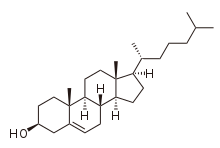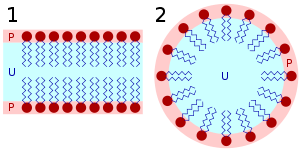Structural Biochemistry/Lipids and Cell Membrane Terms
< Structural BiochemistryStructural Biochemistry Lipids and Cell Membrane Terms And Information
- FATTY ACID: Fatty acids are long hydrocarbon chains of various lengths and degrees of unsaturation with carboxylic acid groups. The fatty acid names are based on the parent hydrocarbon chain. Fatty acids are the key constituents of lipid and lipid owe their hydrophobic properties to them.
- PHOSPHOLIPID: Phospholipids are abundant in all biological membranes and are made up of one or more fatty acids, a platform to which the fatty acids are attached, a phosphate, and an alcohol group. The alcohol group can vary adding additional diversity.
- SPHINGOSINE: Is a more complex alcohol that can be used as a platform in phospholipids. This alcohol is an amino alcohol with a long unsaturated hydrocarbon chain. The amino group here links to the fatty acid through an amide bond.
- PHOSPHOGLYCERIDE: The most common platform for a phospholipid is glycerol. Phosopholipids with glycerol platforms are called phosphoglyceride. These molecules also have two attached fatty acid chains connected with esterified bonds and a phosphate group also connected to the glycerol in an esterified bond.
- GLYCOLIPID: Glycolipids are sugar-containing lipids and are derived from sphingosine. Here the fatty acid is acylated to the amino group and a sugar unit is linked to the primary hydroxyl group.
- CHOLESTEROL: Cholesterol is a lipid with a steroid basis, a hydroxyl group on one end, and a hydrocarbon tail at the other end. Cholesterol is parallel to the fatty acid chains of phospholipids with the hydroxyl group interacting with the polar head groups of the phospholipids.
- AMPHIPHATIC: Amphiphatic molecules contain both a hydrophilic and a hydrophobic part like for example a membrane lipid, which has its hydrophobic fatty acid chains parallel to one another while the hydrophilic head group interacts with the polar media.
- LIPID BILAYER: Lipid bilayers are highly impermeable to ions and polar molecules. Lipid bilayers form from a thin membrane of two layers of lipid molecules, which make a flat, continuous, extensive, self-sealing barrier.
- LIPOSOME: A liposome is also known as a lipid vesicle and has a small aqueous compartment surrounded by a lipid bilayer. This can be used to trap molecules inside and test the permeability of a membrane.
- INTEGRAL MEMBRANE PROTEIN: Integral membrane proteins heavily interact with the hydrocarbon chains of membrane lipids and are released by agents that will fight for the nonpolar interactions.
- PERIPHERAL MEMBRANE PROTEIN: Peripheral membrane proteins are bound to the membrane through electrostatic and hydrogen bond interactions that occur with the polar head groups of the membrane lipids.
- LATERAL DIFFUSION: Lateral diffusion is the constant lateral movement (from side to side) that the lipids undergo in the membrane. This can be proven through photo-bleaching and indicates that the lipid bilayer is an asymmetric fluid structure.
- TRANSVERSE DIFFUSION: Transverse diffusion is when the lipid will flip-flop across the membrane and occurs far less frequently that lateral diffusion.
- MICELLE: It is an aggregate of fatty acid molecules with the hydrophobic tails pointing inward, and the hydrophilic heads pointing outward.
- HYDROPATHY INDEX: Each amino acid residue is given a certain number that represents the extent of the hydrophobic nature of the protein. More hydrophobic amino acids have higher values.
Common Features which underlie the diversity of Biological Membranes
Membrane are diverse in structures and functions. Some important attributes include:
- Have sheetlike structure, two molecules thick which form closed boundaries between different compartment. Thickness of membrane from 60 A (6nm) – 100 A (10nm)
- Consist mainly of lipids / proteins. Mass ratio of lipids to proteins ranges from 1:4 to 4:1.
- Consist of carbohydrates which link to lipids and proteins
- Membrane lipid small molecule which have BOTH hydrophilic and hydrophobic moieties. Lipids form closed bimolecular sheets in aqueous media (lipid bilayers) and are barriers to flow of polar molecules
- Specific protein mediate distinctive function of membranes. Serve as pump, channels, receptors, energy transducer, and enzymes.
- Noncovalent assemblies meaning constituent protein and lipid molecules are held together by noncovalent interactions
- Asymmetric, two faces always differ from one another
- Fluid structures. Lipid molecules diffuse rapidly in plane of membrane along with proteins unless held down by specific interactions. Can be regarded as two-dimensional solutions of oritented protein / lipid
- Most cell membrane electronically polarized. Inside is negative (approximately 60mV). Membrane potential play key role in transport, energy conversion, and excitability
Fatty Acid Key Constituent of Lipids
Fatty acid: long hydrocarbon chains of different length/degree of unsaturation which are terminated with carboxylic acid groups. Name is derived from parent hydrocarbon by substitution of oic for final e.
- EX. C18 saturated fatty acid = octadecanoic acid
- EX. C18 with one double bond = octadecenoic acid
- EX. C18 with two double bond = octadecadienoic acid
- EX. C18 with three double bond = octadecatrienoic acid
How to Name Fatty Acids
- Carbon 2 and 3 referred to as Alpha () and Beta ()
- Methyl carbon at end of chain is called omega ()-carbon atom
- Position of double bond represented by triangle/delta ()followed by superscript number
- EX. cis-9 = cis double bond between carbon 9 and 10
- Position of double bond can be denoted by counting distance from distal end, with omega ()-carbon atom (methyl carbon) as C-1.
- Fatty acids are ionized at physiological pH, refer to them in carboxylate form
Fatty acids vary in chain length and degree of unsaturation (Facts about fatty acids)
- Fatty acid usually contain even number of carbon atoms (between 14-24).
- 16-18 carbon chain fatty acids are most common.
- Configuration of most double bond unsaturated fatty acid is cis
- Alkyl chain may be saturated and can contain one or more double bond
- Unsaturated fatty acid have lower melting point than saturated fatty acids of same length
- Chain length affects melting point , short chain length and unsaturation enhance fluidity of fatty acids and their derivatives
Three major kinds of Membrane Lipids
Phospholipid (major class) - Constructed of four components, one or more fatty acids, platform to which fatty acids are attached, a phosphate, and alcohol attached to phosphate - Provide hydrophobic barrier, whereas remainder of molecule is hydrophilic which aid to enable interaction with aqueous environment
Glycolipid, super-containing lipids - Simplest glycolipid is called cerrebroside, which contains single sugar residue (glucose or galactose)
Cholesterol, steroid built from four linked hydrocarbon rings

Phospholipid and Glyccolipid readily form bimolecular sheets in aqueous media
Membrane formation is a consequence of amphipathic nature of molecules. It helps enable phospholipid to form membrane due to polar head groups favoring contact with water while hydrocarbon tails interact with one another.
- Molecules can use a micelle to arrange themselves [pic of micelle]
- Micelle: process in which polar head groups form the outside surface which is surrounded by water while hydrocarbon tails are inside, interacting with one another

- Favored structure for phosopholipids and gylcolipids are a biomolecular sheet due to two fatty acid chains of phosopholipid/glycolipid are too bulky to fit interior of micelle.
- Size of micelle (less than 200A (20nm) versus size of bimolecular sheet (107 A (106 nm)
- Lipid bilayer form spontaneously by self-assembly process (structure of bimolecular sheet is inherent in structure of constituent lipid molecules)
References
Berg, Jeremy M., Tymoczko, John L., and Stryer, Lubert. Biochemistry. 6th ed. New York, N.Y.: W.H. Freeman and Company, 2007.
Biochemistry Berg 7th Edition